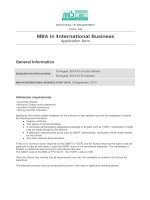International business 7e czinkota moffett ch10
Bạn đang xem bản rút gọn của tài liệu. Xem và tải ngay bản đầy đủ của tài liệu tại đây (705.94 KB, 25 trang )
Chapter 10
Building the Knowledge
Base
1
Learning Objectives
To gain an understanding of the need for
research.
To explore the differences between
domestic and international research.
To learn where to find and how to use
sources of secondary information.
To gain insight into the gathering of
primary data.
To examine the need for international
management information systems.
2
International and
Domestic Research
The tools and
techniques of
international research
are the same as those
of domestic research.
The difference is in the
environment to which
the tools are applied.
3
International and
Domestic Research (cont.)
The four primary reasons for the
differences between international and
domestic research are:
New Parameters
New Environmental
Factors
A Broader Definition
of Competition
An Increase in the
Number
of Factors Involved
4
New Parameters
In crossing international borders, a
firm encounters parameters not
found in domestic business.
Examples include:
Duties
Foreign currencies and changes in their value
Different modes of transportation
International documentation
Differing modes of operating internationally
5
New Environmental
Factors
Many of the domestic assumptions
on which the firm and its activities
were founded may not hold true
internationally.
Management needs to:
Learn the culture of the host country
Understand its political systems and level of
stability
Comprehend the existing differences in
societal structures and language
Understand pertinent legal issues
6
The Number of Factors
Involved
When a firm enters a new international
market, the number of changing
dimensions increases.
Coordination of the interaction among
the dimensions is crucial to the
international success of the firm for two
reasons:
In order to exercise some central control over
international operations, a firm must be able to
compare results and activities across countries.
The firm must be able to learn from its international
operations and must find new ways to apply the
new lessons learned to different markets.
7
Broader Definition of
Competition
The international market
exposes the firm to much
greater variety of
competition than that found
in the home market.
Firms must:
Determine the breadth of the
competition,
Track competitive activities,
Evaluate their actual and potential
impact on company operations on an
ongoing basis.
8
Lack of International
Research
International research is often less rigorous,
less formal, and less quantitative than
domestic research.
The four reasons why managers are reluctant
to engage in international research are:
Their lack of sensitivity to differences in culture,
consumer tastes, and market demands.
Limited appreciation for different environments
abroad.
Lack of familiarity with national and international
data sources.
Firms build international business activities gradually,
frequently based on unsolicited orders.
9
The Importance of
International Research
Firms must learn where the opportunities
are, what customers want, why they want it,
and how they satisfy their needs and wants.
Research allows management to identify
and develop international strategies.
Firms must identify, evaluate, and compare
potential foreign business opportunities and
the subsequent target market selection.
Research is necessary for the development
of a business plan.
10
Determining Research
Objectives
As a starting point,
research objectives must
be determined for a firm.
These objectives will
depend on the views of
management, the
corporate mission of the
firm, the firm’s level of
internationalization, and
its competitive situation.
11
Going InternationalExporting
A frequent objective of international
research is that of foreign market
opportunity analysis. The aim is to utilize
a broad-brush approach.
Steps to this approach include:
A cursory analysis of general variables of a
country.
A preliminary evaluation of each individual
country.
Selection of appropriate markets for in-depth
evaluation.
Finally, a competitive assessment must be made.
12
Process of Researching
Foreign Market Potentials
Stage One
Preliminary Screening for Attractive Country Markets
Key Question to be answered:
Which foreign markets warrant detailed information?
Stage Two
Assessment of Industry Market Potential
Key Question to be answered:
What is the aggregate demand in each of the selected markets?
Stage Three
Company Sales and Promotion Analysis
Key Question to be answered:
How attractive is the potential demand for our products and services?
13
Going InternationalImporting
When importing, the major focus shifts
from supplying to sourcing.
Management must identify markets that
produce suppliers or materials desired.
The importer needs to know:
The reliability of a foreign supplier,
The consistency of its product or service quality,
The length of delivery time,
Government rules and restrictions of the
exporting country
14
Secondary Data
Secondary data is information that already has
been collected by some other organization.
This data should be evaluated regarding the
quality of the source, how recent the data is,
and the relevance to the task at hand.
Because secondary data were originally
collected to serve another purpose, they can
often only be used as proxy information.
Precautions should be taken due to increasing
sensitivity to data privacy. Firms must inform
their customers of privacy policies.
15
Sources of Secondary
Data
Other Firms
Directories
Governments
International
Institutions
Trade Associations
Service
Organizations
16
Conducting Primary
Research
Primary data are obtained
by a firm to fill specific
information needs.
The researcher must
decide whether research
is to be conducted in the
consumer or the
industrial product area.
17
Determining the Research
Technique
Selection of the research technique
depends on a variety of factors:
The objectivity of the data sought must be
determined. Unstructured data will require
more open-ended questions and more time
than structured data.
Whether the data should be collected in the
real world or in a controlled environment.
Whether to collect historical facts or
information about future developments.
18
Research Techniques
Interviews
Focus Groups
Surveys
Observation
Use of Web
Technology
19
The International
Information System
An information system is the systematic and
continuous gathering, analysis, and reporting
of data for decision-making purposes.
To be useful, the information system must be:
Relevant
Timely
Flexible
Accurate
Exhaustive
Consistent
Convenient
20
Export Complaint
Systems
An export complaint system allows
customers to contact the original
supplier of a product in order to
inquire about products, make
suggestions, or to present complaints.
A firm must be able to aggregate and
analyze complaints and to make use of
them internally.
Increasingly, the Internet enables
customers to provide feedback on their
experiences with a firm.
21
The Mechanisms of Export
Complaint Systems
Environmental
Scanning
Delphi Studies
Scenario Building
22
Environmental
Scanning
Environmental scanning activities
provide continuous information on:
Political, social, and economic affairs
internationally
Changes of attitudes of public
institutions and private citizens
Possible upcoming alterations
Two significant methods of
environmental scanning are
obtaining factual input and content
analysis.
23
Delphi Studies
Delphi studies are a means for
aggregating the judgements of
a number of experts who cannot
come together physically.
The Delphi technique is
particularly valuable because it
uses mail, fax, or electronic
communication to bridge large
distances and therefore makes
experts accessible at a
reasonable cost.
24
Scenario Building
Scenario building involves the identification
of crucial variables and the degree of
variation.
The possibility of joint occurrences must be
recognized.
For scenarios to be useful, managers must
analyze and respond to them by
formulating contingency plans.
Through the anticipation of possible
problems, managers hone their response
capability and in turn shorten response
times to actual problems.
25









